RX Mixer (QSD) Introduction
Theory of Operation
The mixer stage ("QSD" - Quadrature Sampling Detector) acts like two traditional direct conversion mixers operating in tandem. Each takes in half of the filtered RF from the bandpass filter stage and one of the quadrature center frequency signals, then "mixes"/down-converts them to with an output being the traditional mixer products, in this case, two (infra) audio frequency signals that represent the difference between the two inputs (RF and Local Oscillator). These two signals are referred to as the detected I (in-phase) and Q (Quadrature) signals and are fed into the high gain Op-Amps stage for amplification and delivery to the audio outputs (and, thence, to the PC's sound card). The mixer is enabled by the QSD enable line, switched in the RF I/O Control Stage's Q9. When the PTT line is activated, the QSD Enabling line goes high and disables the RX Mixer.
(go directly to build notes)RX Mixer (QSD) Schematic
(Resistor testpoints (hairpin, top, or left-hand lead), as physically installed on the board, are marked in the schematic with red dots)
(Click for Full Schematic)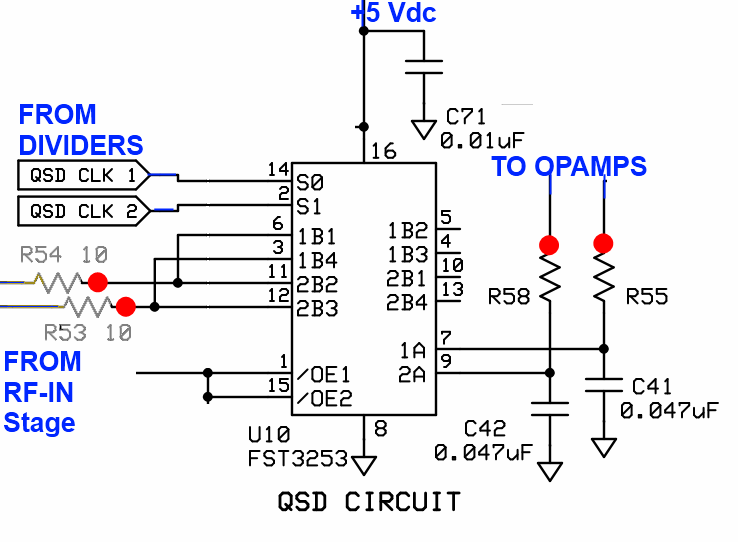
(above schematic has clickable areas that can be used for navigation)
(go directly to build notes)RX Mixer (QSD) Bill of Materials
Stage Bill of Materials
(resistor images and color codes courtesy of WIlfried, DL5SWB's R-Color Code program)
| Check | Count | Component | Marking | Category |
|---|---|---|---|---|
| ❏ | 2 | 0.047 uF 5% | 473
 | Ceramic |
| ❏ | 2 | band-specific | misc | |
| ❏ | 1 | 0.01 uF | (smt)
 | SMT 1206 |
| ❏ | 1 | FST3253 mux/demux switch | FST3253
 | SOIC-16 |
Band Specific Items for 160m Band
| Check | Designation | Component | Marking | Category | Orientation | Notes | Circuit |
|---|---|---|---|---|---|---|---|
| ❏ | R55 | 49.9 ohm 1% | yel-wht-wht-gld-brn
 | 1/4W | N-S | RX Mixer (QSD) | |
| ❏ | R58 | 49.9 ohm 1% | yel-wht-wht-gld-brn
 | 1/4W | N-S | RX Mixer (QSD) |
Band Specific Items for 80, 40m Band
| Check | Designation | Component | Marking | Category | Orientation | Notes | Circuit |
|---|---|---|---|---|---|---|---|
| ❏ | R55 | 49.9 ohm 1% | yel-wht-wht-gld-brn
 | 1/4W | N-S | RX Mixer (QSD) | |
| ❏ | R58 | 49.9 ohm 1% | yel-wht-wht-gld-brn
 | 1/4W | N-S | RX Mixer (QSD) |
Band Specific Items for 40, 30, 20m Band
| Check | Designation | Component | Marking | Category | Orientation | Notes | Circuit |
|---|---|---|---|---|---|---|---|
| ❏ | R55 | 10 ohm 1/4W 1% | br-blk-blk-gld-br
 | 1/4W | N-S | RX Mixer (QSD) | |
| ❏ | R58 | 10 ohm 1/4W 1% | br-blk-blk-gld-br
 | 1/4W | N-S | RX Mixer (QSD) |
Band Specific Items for 30, 20, 17m Band
| Check | Designation | Component | Marking | Category | Orientation | Notes | Circuit |
|---|---|---|---|---|---|---|---|
| ❏ | R55 | 10 ohm 1/4W 1% | br-blk-blk-gld-br
 | 1/4W | N-S | RX Mixer (QSD) | |
| ❏ | R58 | 10 ohm 1/4W 1% | br-blk-blk-gld-br
 | 1/4W | N-S | RX Mixer (QSD) |
Band Specific Items for 15, 12, 10m Band
| Check | Designation | Component | Marking | Category | Orientation | Notes | Circuit |
|---|---|---|---|---|---|---|---|
| ❏ | R55 | 10 ohm 1/4W 1% | br-blk-blk-gld-br
 | 1/4W | N-S | RX Mixer (QSD) | |
| ❏ | R58 | 10 ohm 1/4W 1% | br-blk-blk-gld-br
 | 1/4W | N-S | RX Mixer (QSD) |
RX Mixer (QSD) Summary Build Notes
- Install Topside Components
- Install Band-specific Components
- Install Bottomside Components
- Test the Stage
RX Mixer (QSD) Detailed Build Notes
Top of the Board
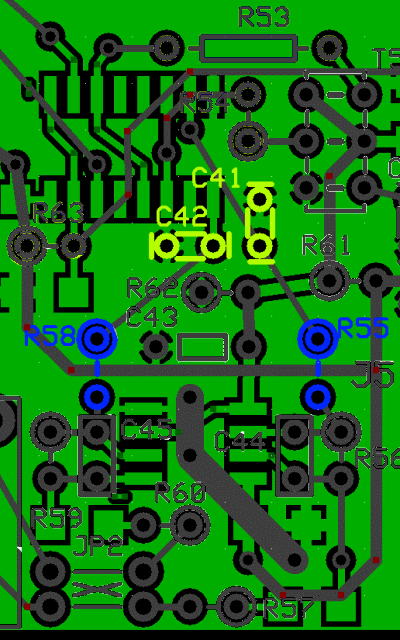
Install Topside Components
| Check | Designation | Component | Marking | Category | Orientation | Notes |
|---|---|---|---|---|---|---|
| ❏ | C41 | 0.047 uF 5% | 473
 | Ceramic | ||
| ❏ | C42 | 0.047 uF 5% | 473
 | Ceramic |
Install Band-specific Components
The band-specific resistors are either 49.9 or 10 ohms (both have a GOLD 4th band. Do not get them mixed up with 10k or 4.99k resistors.
| Check | Designation | Component | Marking | Category | Orientation | Notes | ||||||||||||||||||
|---|---|---|---|---|---|---|---|---|---|---|---|---|---|---|---|---|---|---|---|---|---|---|---|---|
| ❏ | R55 | band-specific |
| misc | N-S | |||||||||||||||||||
| ❏ | R58 | band-specific |
| misc | N-S |
Bottom of the Board
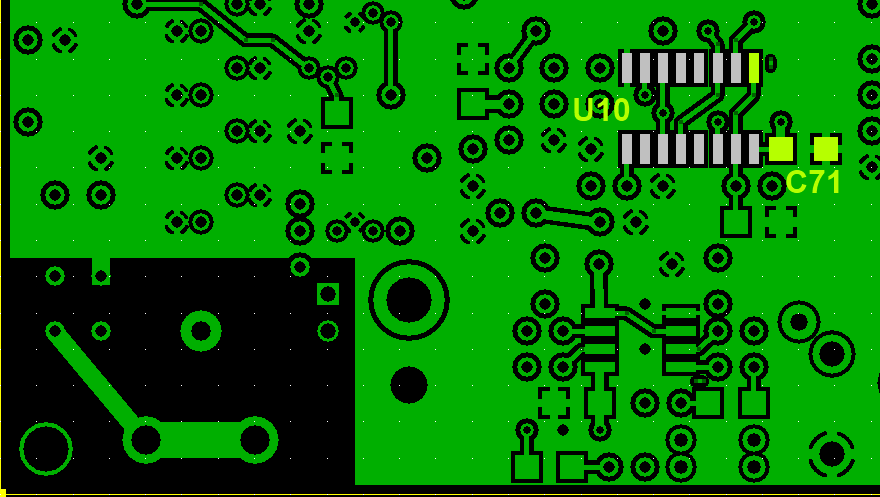
Install Bottomside Components
| Check | Designation | Component | Marking | Category | Orientation | Notes |
|---|---|---|---|---|---|---|
| ❏ | U10 | FST3253 mux/demux switch | FST3253
 | SOIC-16 | Take ESD precautions | |
| ❏ | C71 | 0.01 uF | (smt)
 | SMT 1206 |
RX Mixer (QSD) Completed Stage
Author, while testing in this stage, accidentally shorted the 12V supply. The result was that the trace from the power socket to the diode was vaporized and had to be replaced with an underside patch. Also, this managed to "fry" the 74AC74 Quad Clock Generator IC:
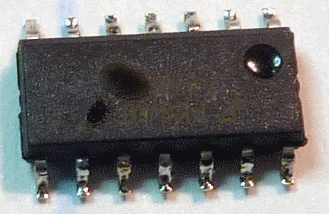
Top of the Board
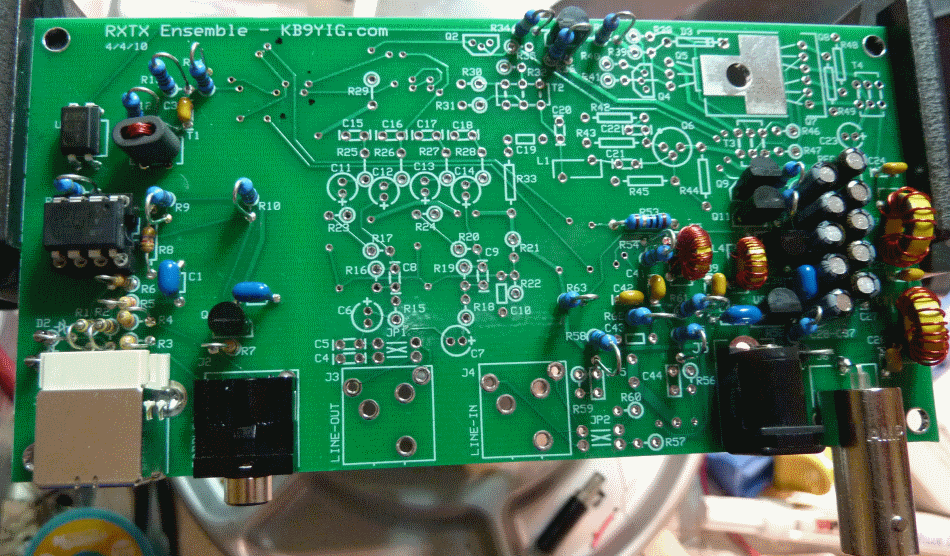
Bottom of the Board
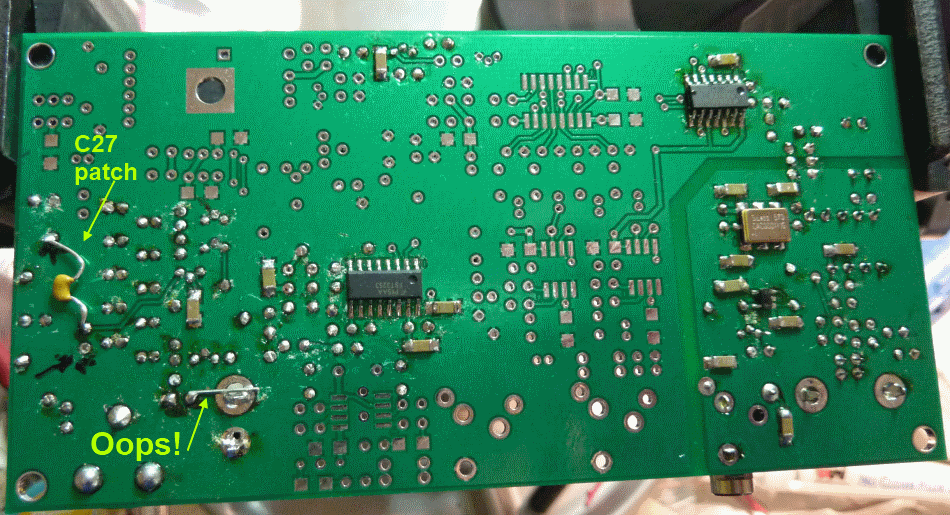
RX Mixer (QSD) Testing
IC Pin Voltages
Test Setup
Test Setup
Note: The additional current draw of U10 is so low, the current draw test from the preceding stage should suffice
Voltages are measured WRT (regular) ground (R50 hairpin)
Power the board, connect USB to PC, run Rocky (to send PTT signal)
Measure pin voltages with PTT OFF
Measure Pin 1 and 15 voltages with PTT ON
It is best to test for these voltages at the actual pins (not the pads), thereby ensuring correct soldering of the pins to the pads.
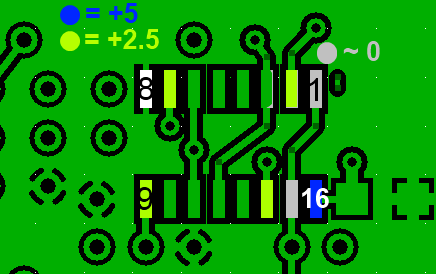
Test Measurements
| Testpoint | Units | Nominal Value | Author's | Yours |
|---|---|---|---|---|
| Pin 8 | Vdc | 0 | 0 | _______ |
| Pins 1 and 15 (PTT OFF) | mVdc | 0 - 50 | 50 | _______ |
| Pin 2 (from Divider) | Vdc | 2.5 | 2.47 | _______ |
| Pin 14 (from Divider) | Vdc | 2.5 | 2.47 | _______ |
| Pin 7 (to OpAmp) | Vdc | 2.5 | 2.48 | _______ |
| Pin 9 (to OpAmp) | Vdc | 2.5 | 2.48 | _______ |
| Pin 16 (Vdd) | Vdc | 5 | 4.95 | _______ |
| Pins 1 and 15 (PTT ON) | Vdc | high (Vdc) | 4.95 | _______ |
Optional Mixer Test
Test Setup
Test Requirement (Optional)
At the antenna input, inject a signal that is 10 kHz above or below the selected center frequency.
Probe the hairpin leads of R55 and R58 for a 10 kHz audio frequency signal (in quadrature). You may use the hairpin of R50 for a ground point.

